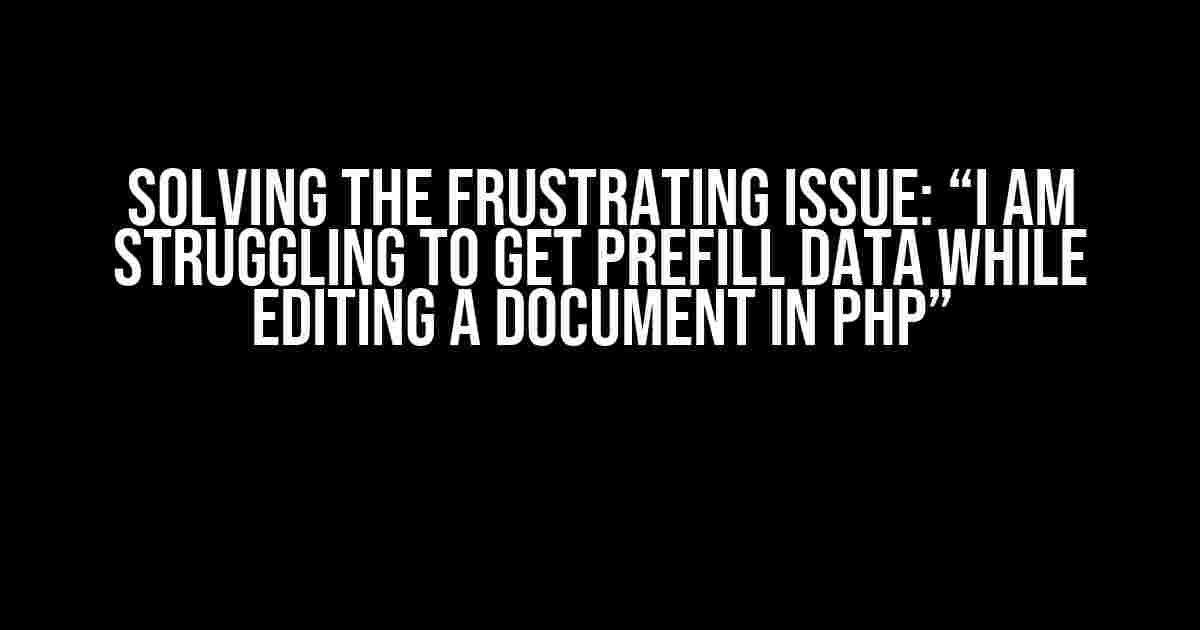Are you tired of banging your head against the wall, trying to figure out why you can’t get prefill data while editing a document in PHP? You’re not alone! Many developers have faced this frustrating issue, and it’s time to put an end to it. In this article, we’ll dive deep into the world of PHP and document editing, providing you with clear and direct instructions to overcome this obstacle.
Understanding the Problem: What is Prefill Data?
Prefill data is the information that is automatically populated in a document or form when a user opens it for editing. This data is usually retrieved from a database or an external source, making it easier for users to review and update their information. However, when this data doesn’t load, it can be a major headache for developers.
The Common Causes of Prefill Data Issues
Before we dive into the solutions, let’s take a look at some common causes of prefill data issues:
- Incorrect database connection or configuration
- Broken or missing queries to retrieve the data
- Insufficient permissions or access control
- Incompatible data formats or encoding issues
- Buggy or outdated PHP versions
Step-by-Step Solution: Getting Prefill Data While Editing a Document in PHP
Now that we’ve identified the potential causes, let’s move on to the step-by-step solution:
Step 1: Verify Your Database Connection
The first step is to ensure that your database connection is correct and functional. Make sure you have the correct database credentials, hostname, and database name.
<?php
$db_host = 'localhost';
$db_username = 'your_username';
$db_password = 'your_password';
$db_name = 'your_database';
$conn = mysqli_connect($db_host, $db_username, $db_password, $db_name);
if (!$conn) {
die("Connection failed: " . mysqli_connect_error());
}
?>
Step 2: Write the Query to Retrieve the Data
Next, you need to write a query to retrieve the data from the database. Make sure to use the correct table name, column names, and any necessary conditions or filters.
<?php
$query = "SELECT * FROM your_table WHERE user_id = '$user_id'";
$result = mysqli_query($conn, $query);
if (!$result) {
die("Query failed: " . mysqli_error($conn));
}
?>
Step 3: Fetch the Data and Store it in a Variable
Once you have the query result, you need to fetch the data and store it in a variable. You can use the `mysqli_fetch_assoc()` function to retrieve the data as an associative array.
<?php
$data = array();
while ($row = mysqli_fetch_assoc($result)) {
$data[] = $row;
}
?>
Step 4: Populate the Document with the Prefill Data
Now that you have the data, it’s time to populate the document with the prefill data. You can use PHP to generate the HTML for the document and populate the fields with the retrieved data.
<?php
foreach ($data as $item) {
echo "<input type='text' value='" . $item['field_name'] . "' />";
}
?>
Step 5: Troubleshoot and Optimize
The final step is to troubleshoot and optimize your code. Make sure to check for any errors, warnings, or notices, and optimize your code for better performance.
<?php
error_reporting(E_ALL);
ini_set('display_errors', 1);
// Optimize your database queries and PHP code
?>
Common Pitfalls to Avoid
While following the steps above, make sure to avoid these common pitfalls:
| Pitfall | Description |
|---|---|
| Not validating user input | Failing to validate user input can lead to SQL injection and other security issues. |
| Not handling errors and exceptions | Failing to handle errors and exceptions can lead to application crashes and data loss. |
| Not optimizing database queries | Failing to optimize database queries can lead to slow performance and high server loads. |
Best Practices for Prefill Data in PHP
To ensure seamless prefill data functionality, follow these best practices:
- Use prepared statements to prevent SQL injection
- Validate and sanitize user input data
- Use error handling and exception handling mechanisms
- Optimize database queries for better performance
- Use secure and efficient data storage mechanisms
- Regularly update and maintain your PHP version and dependencies
By following these steps, tips, and best practices, you should be able to overcome the frustrating issue of not getting prefill data while editing a document in PHP. Remember to stay calm, patient, and persistent, and don’t hesitate to reach out for help if you need it.
Conclusion
Prefill data is an essential feature in many applications, and getting it to work correctly can be a challenge. However, with the right approach and techniques, you can overcome this obstacle and provide a seamless user experience. By following the instructions and guidelines outlined in this article, you’ll be well on your way to resolving the issue and creating a robust and efficient PHP application.
Remember, practice makes perfect, so don’t be afraid to try and experiment with different approaches until you find the one that works best for you. Happy coding!
Keywords: prefill data, PHP, document editing, database connection, query, data retrieval, error handling, optimization, best practices.
Frequently Asked Question
Are you tired of scratching your head while trying to get prefill data while editing a document in PHP? Don’t worry, we’ve got you covered!
Why is my prefill data not showing up when I edit a document in PHP?
Make sure you’re using the correct syntax and method to retrieve the prefill data. Check if your PHP code is fetching the data correctly and if the data is being passed to the editing interface correctly. Also, ensure that the data is not being overridden or cleared somewhere in the code.
Is there a specific PHP function or method that I can use to prefill data while editing a document?
You can use the PHP `isset()` function to check if the prefill data exists, and then use the `htmlspecialchars()` function to encode the data for display in the editing interface. Additionally, you can use PHP’s built-in `json_encode()` function to encode the data into a JSON format that can be easily consumed by JavaScript.
How do I ensure that my prefill data is correctly formatted for editing in a PHP-based document editor?
Use a consistent data format such as JSON or XML to store and retrieve your prefill data. Make sure to validate and sanitize the data before displaying it in the editing interface to prevent any security vulnerabilities. Also, consider using a PHP library or framework that provides built-in support for data formatting and validation.
Can I use JavaScript to prefill data in a PHP-based document editor?
Yes, you can use JavaScript to prefill data in a PHP-based document editor. PHP can generate the initial HTML content, and then JavaScript can be used to dynamically populate the editing interface with the prefill data. Use JavaScript libraries like jQuery or VanillaJS to access and manipulate the HTML elements that need to be prefilled with data.
What are some common mistakes to avoid when prefilling data in a PHP-based document editor?
Common mistakes to avoid include not validating and sanitizing the prefill data, not using a consistent data format, and not separating concerns between PHP and JavaScript code. Additionally, avoid using outdated or deprecated PHP functions and methods, and make sure to test and debug your code thoroughly to ensure that the prefill data is displayed correctly and securely.



